Jian Zhan (建盏), also known as Jian Ware, originates from Jianyang, China, and is a distinctive type of Chinese pottery. In Japan, it is referred to as 'Tenmoku' (天目). While various forms of Jian Zhan pottery exist, bowls and cups stand out as the most popular crafted items. The allure of these cups lies in their rich, dark glaze adorned with captivating 'special effects.' Achieved through high-temperature firing, the glaze crystallizes, giving rise to intricate patterns such as stripes, feathers, or oil spots.
This article delves into the historical origins of Tenmoku, exploring its evolution, the craftsmanship behind cup production, and the potential enhancements it brings to your tea-drinking experience.
Jian Ware: Unveiling Historical Significance
With roots tracing back to the Tang Dynasty (618 to 907), Jian Ware rose to prominence during the subsequent Song Dynasty (960–127). While the Tang era witnessed the preparation of tea from tea cakes, with an emphasis on appreciating the subtleties in light-colored tea ware, a significant shift occurred during the Song Dynasty.
The transition to 'whipped tea' marked a pivotal moment. Compressed tea cakes evolved into powdered form, whipped into a thick broth within large bowls or tea cups. This transformative practice gave rise to the preference for sizable and dark Jian Zhan tea cups. These cups, characterized by their depth of color, aligned seamlessly with the intense hue of the whipped tea, becoming an integral element of the evolving tea culture during the Song Dynasty.
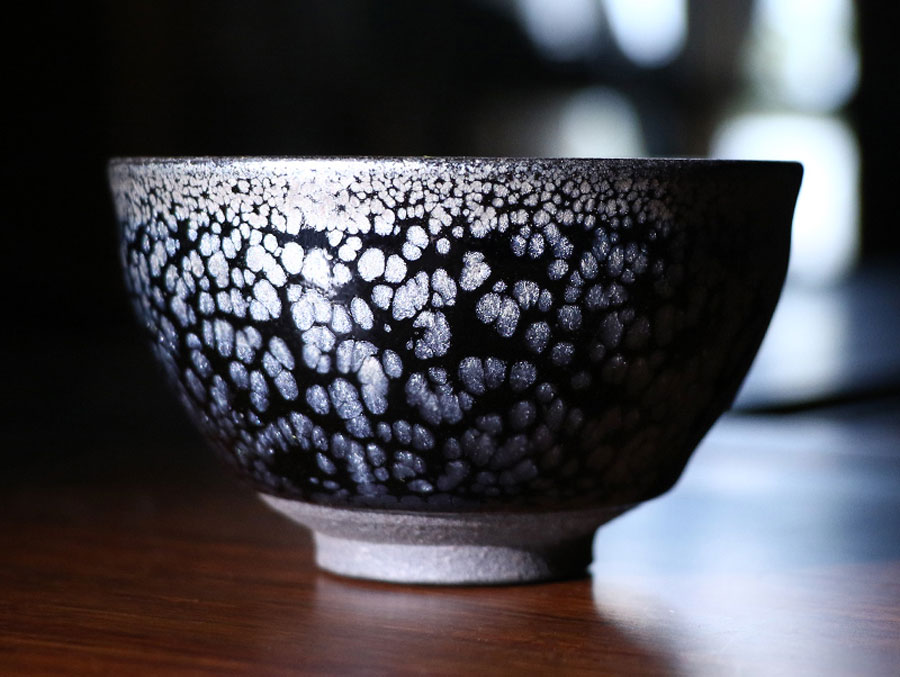
Evolution of Jian Zhan Tea Cups: A Transition Through Time
As early as the Yuan Dynasty, the allure of Jian Zhan tea cups began to wane, influenced by the gradual dominance of the 'steeped tea' concept, a departure from the erstwhile tradition of whipped tea.
Fortunately, in the last decade, Chinese ceramic artists have embarked on a journey to revive the artistry of Jian ware. This revival breathes new life into the craftsmanship of Jian cups, steering away from the conventional and exploring a spectrum of colors. Contemporary artisans experiment with diverse material specifications for glazes and varying firing temperatures, resulting in a diverse array of Jian cups.
Notably, the resurgence of Jian ware extends beyond historical boundaries, with Tenmoku cups now finding a place in the world of loose leaf teas. This adaptation reflects a harmonious blend of tradition and modern preferences, ensuring the continued relevance and appreciation of Jian Zhan tea cups in today's tea culture.
Jian Zhan vs. Tenmoku: A Tale of Names
The journey of tea culture transcended borders as Japanese monks introduced powdered tea, known as 'Matcha,' to Japan. In parallel with this cultural exchange, the Japanese began producing their own version of Jian Ware, affectionately naming it 'Tenmoku.' Consequently, two distinct terms emerged to describe these cups, reflecting the unique characteristics and cultural adaptations associated with each.
The coexistence of Jian Zhan and Tenmoku underscores the cross-cultural influence and the ability of tea traditions to evolve. While Jian Zhan has its roots in Chinese history, Tenmoku, born from the Japanese interpretation of Jian Ware, embodies a fusion of traditions. Today, these terms stand side by side, each carrying its own historical and cultural significance in the realm of tea.
Jian Zhan Tea Cup Process: How is Tenmoku made?
Material Selection & Preparation in Jian Ware Craftsmanship
The foundation of exceptional Jian Ware lies in meticulous material selection and preparation. Both the glaze and clay demand a high iron content, a criterion met by the natural resources of Jianzhou, which consequently became the epicenter for this distinct pottery. During the Song Dynasty, attempts by other regions to replicate the quality of Jianyao’s cups were futile due to the lower iron content in their local ore.
The chosen materials undergo a rigorous process of crushing and sieving to attain a judicious thickness. The resulting clay slurry and glaze are then stored in a controlled environment with regulated humidity and temperature. Today, advancements in technology make the crushing process more efficient, yet the artist's vigilance remains crucial to ensure uniformity and prevent cracking during firing.
Shaping and Firing the Base
Once the clay is prepared, it undergoes kneading to eliminate air and enhance density. Handcrafted on a turning table, tea cups take shape under the skilled hands of the artist. This labor-intensive process, though time-honored, ensures each cup is unique, reflecting the artisan's dedication to preserving the traditional craftsmanship of shaping and firing the base.

Afterwards, a small knife/tool is used to modify and perfect tea cup.
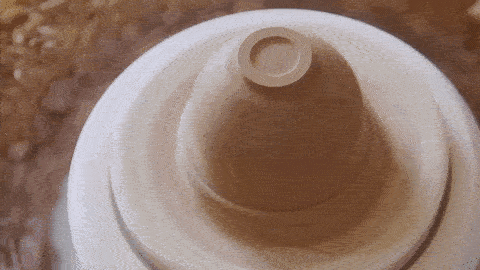
At last, the unglazed tea cup is fired. This process will strengthen the cup and filter out those cups that are fragile.
Tenmoku Glaze & Firing: Crafting Elegance
After the meticulous creation of the base tea cup, the transformative process begins with glazing. The unique Tenmoku glaze is crafted using a blend of natural iron ore and plant ash, meticulously combined to create a harmonious composition.
The complexity of the glazing process lies in the careful selection of different iron ore and plant ash variations. This deliberate choice influences the crystallization patterns that emerge during the high-temperature firing. Achieving the perfect blend poses a challenge, as the raw materials possess inherently unique characteristics. Ceramic artists engage in a nuanced tweaking process to attain the desired result, often opting to procure a surplus of raw materials to minimize the need for frequent adjustments.
Jian Zhan tea cups, exemplifying a characteristic half-glazed appearance, undergo a specific glazing technique. The cups are skillfully dipped into the glaze, leaving the bottom part unglazed. This practice, refined through extensive practice, demands a delicate balance—ensuring the glaze is neither too thin, allowing for proper crystallization during firing, nor too thick, preventing the glaze from adhering excessively to the bottom. The mastery of this artistry lies in the hands of the ceramic artist, who, through dedication and skill, brings forth the elegant fusion of form and glaze in every Jian Zhan tea cup.
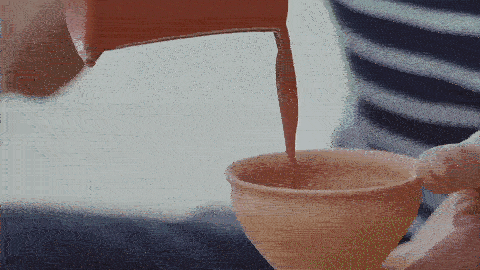
Once the glaze is applied, it will be put into an oven and fired at a temperature around 1300ºC (2370ºF). It's said that firing the oven using pinewood offers the best effect.

Precision in Firing: Crafting with Exactitude
The temperature during firing becomes a critical parameter, subject to slight adjustments based on the specific glaze type and the desired crystallization effects envisioned by the artist. This intricate process, akin to an exact science, demands meticulous attention, as a variance of a few degrees can dramatically alter the final outcome. Notably, the art of Jian Zhan involves a delicate dance of temperatures, where nuanced adjustments contribute to the emergence of unique patterns and colors in the crystallization process.
An intriguing facet of this craft lies in the occasional discovery of new patterns and colors, often stemming from unintentional mistakes in glaze blending or variations in oven temperatures. These unplanned occurrences add an element of serendipity to the artistry, unveiling unexpected beauty born from experimentation.
Upon the completion of the firing process, the artist assumes the role of a discerning curator, carefully examining the quality of each individual cup. Cups that bear cracks or imperfections, no matter how minor, are deemed unworthy and respectfully disposed of. This commitment to quality control ensures that only the finest, flawless Jian Zhan tea cups make their way to tea enthusiasts, preserving the legacy of this ancient art form.
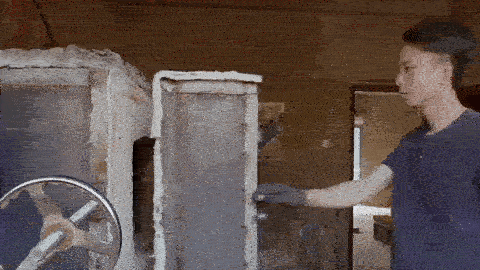
The cups that pass the quality inspection will be divided into different grades and sold to tea enthusiasts.
When you order Jian Zhan from GOSHLE, you'll be assured that:
- We never ship you a faulty Jian Zhan cup. These will be filtered out during our procurement process.
- The measure of the cup will only differ by only +/- 3mm (0.12in) relative to the specified measures on the product page.
- The glaze fully covers the inside of the tea cup. The base cup surface is not visible.
- The glaze on the inside and the outside don't have holes.
- The glaze and its crystallization is considered to be of great quality by our Jian ware experts.
Jian Zhan & Temoku Tea Cup Benefits
Heat retention
Because Jian Zhan ceramics are dense, thick, and high temperature fired, they retain heat better than most other kinds of ceramics. Thus, using Jian Zhan can keep your tea warm for longer.
Taste improvement
The chemical composition (especially iron content) of the Tenmoku glaze also improve the alkalinity of your tea liquor. As a result, the tea texture becomes softer and smoother, and the flavour becomes more sweet. The same holds when you serve water or coffee in Jian Ware. For the same reason, people in China love to boil water in iron teapots for steeping tea.
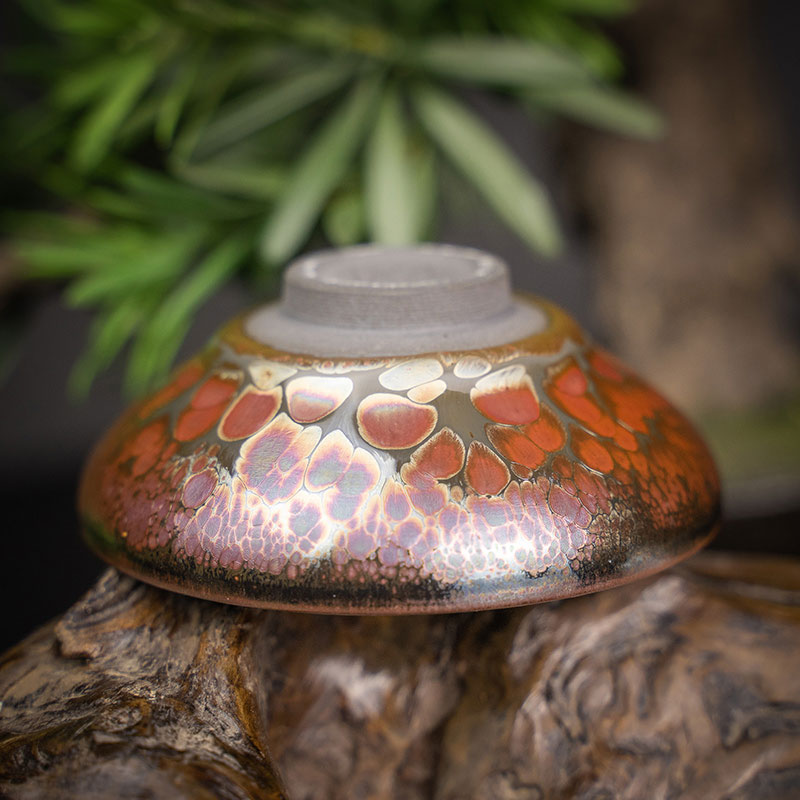
If you own a tenmoku cup, you may test this yourself at home. Serve hot tea in a tenmoku cup and normal glass cup, then wait for 2 minutes to allow it to cool down, and taste. Do you notice the different? Please share your experience in the comment section below!
Improve Health
The high iron content of Jian Zhan can continuously release divalent iron ions during use, and can absorb chloride ions in water, which can be easily absorbed by the human body, thereby increasing the carrier of hemoglobin and the function of red blood cells. It can prevent anemia and high blood pressure, regulate the central nervous system of the human body, and achieve a soothing effect. In addition, it is also effective in balancing the endocrine system. It can adsorb bacteria and reverse the inhibition of the enzyme activity that bacteria depend on and oxygen to achieve a sterilization effect.
The aluminum content in Jian Zhan can release trace amounts of aluminum ions, oxygen ions and can absorb fluoride ions in water.
At last, tea in a Jian Zhan can be preserved for longer than in normal porcelain ceramic. You may store tea in a porcelain cup and a Jian Zhan cup. Cover the cup with a lid and store it for half a day. You will experience that the tea in the Jian Zhan has the flavour close to the original flavour while the tea in the porcelain cup tastes stale.
Other Facts & Questions about Jian Zhan / Tenmoku
- No tenmoku cup is the same: A traditionally made tenmoku cup is always unique. This is because the base of the cup is handcrafted from clay, and the glaze is naturally formed through crystallization during high temperature oven firing.
- Is tenmoku glaze food safe: The glaze of a tenmoku cup is not toxic. It's made from a blend of iron ore and plant ash, and is completely food safe. This is because the high temperature firing has made the glaze unleachable. A good way to verify this is to pour lemon juice or vinegar in your Jian cup and leave it overnight. If the colour of the glaze changes, it means the glaze is leached by the acid of lemon/vinegar, meaning it's not food safe. Of course, if you see that your cup is not fully glazed, meaning that a part of the base is shown on the inside of the cup, then your cup is not food safe. When you see holes or cracks on the inside of the Jian Zhan tea cup, then it's also not food safe.
- What is tenmoku glaze?: The glaze of a tenmoku cup revers to the outside coating of the base clay cup.
- How to make a tenmoku glaze recipe for blue or gold colour?: As we explained above, the iron ore and plant ash speficiations is different from region to region, and thus the right blend should be determined through experimentation. It's therefore not possible to provide you an exact recipe.